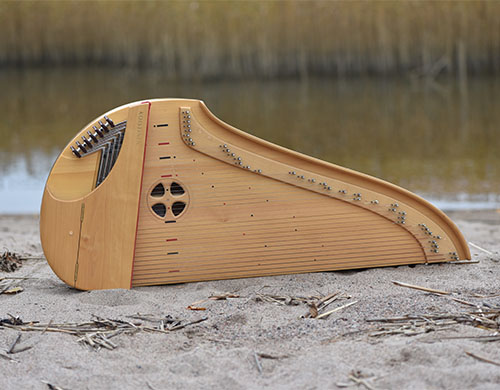KANTELE

The kantele is the national instrument of Finland. It is an important symbol of the Finnish national identity often depicted in the art of the Romantic era in the late 19th century. It’s not closely related to the harp or dulcimer although they have similarities in structure. Kantele instruments (although named differently) can be found in the Baltic countries and Russia. The instrument has been estimated to have existed for some 2000 years. The earliest forms have probably featured a small amount of strings – perhaps five. The five stringed kantele still remains the basic form of the modern kantele.
The kantele is a diatonic instrument. This means that the instrument has been tuned to a certain key or mode. Notes that don’t belong to the key can thus not be played without re-tuning the instrument. An exception for this is the concert kantele with the mechanism to produce all missing half steps by turning special metal slides. Normally a kantele is tuned so that each note of the key can be found in consecutive order. E.g. In D major, an 11 stringed instrument’s lowest and longest string would be tuned to “a” and the consecutive strings would be tuned to “h” (or “b”), “c#1”, “d1”, “e1”, “f#1”, “g1”, “a1”, “h1” (or “b1”), “c#2”, “d2”.
Small kanteles which feature some 5 to 20 strings are usually played with the shortest and highest string closest to the player. Plucking is the most common technique which can be used to play melodies often added with accompanying notes. In this technique both hands of the player have an equal role producing both melody and accompaniment notes. Chords can be played by pulling multiple strings with the index finger of the right hand or a plectrum. Simultaneously the left hand is used to mute strings that don’t belong to the chords. You can play either sitting down with or without a table or standing up. A strap is needed when standing while playing.
The big kanteles which feature over 30 strings are played with a different technique. Usually, due to the size of the instrument and ergonomics, a table is needed when playing larger kanteles. They are played either from the short side with the shortest string facing the player or from the long side with the longest string facing the player. The string is not picked upwards as one would pick the string of a small kantele but it’s rather pulled towards the player with the finger ending up on the string next to the one being sounded. Each hand has a special role: usually the right hand plays the melody and the left hand plays chords. Big kanteles (a.k.a box kanteles) were developed during the 19th century when the kantele players required more strings to be able to play modern music. At this point the building technique had to be changed also. Whereas small kanteles were usually built from a single piece of wood by carving, big kanteles require construction from several pieces of board. The kantele with halftone mechanics was developed by Paul Salminen in the 1920’s. This made the use of kantele possible in e.g. classical and pop music. The ambitus of a big kantele nowadays ranges from G1 to c4.
The sound of a kantele is quiet compared to modern instruments like violin or accordion. In earlier days the world was not as noisy as it is now and instruments were not required to be loud. This is one of the reasons why kantele was in danger of extinction when new instruments became popular. Nowadays kanteles are often amplified with microphones to reinforce the sound in concert situations.
In Perhonjokilaakso of the Finnish Ostrobothnia the traditional style of playing the big kantele has been preserved to these days but the tradition of the small kantele has been revived much relying on archive tapes recorded in the beginning of the 20th century in Eastern Finland and Karelia. Nowaday the kantele, however, is alive and well. There are thousands of kantele players and dozens of professional kantele musicians in Finland and the instrument has friends abroad also.
Kardemimmit play 15 stringed instruments which have 4 stringed mostly used for accompaniment (D, d, a, a) and 11 normal strings (a-d2). These instruments differ from the traditional small kanteles which don’t feature special accompaniment strings or the wing like shape that has been added to amplify the sound acoustically. In most of the tunes a 38-stringed concert kantele is also used, often as the instrument providing the bass tones.
